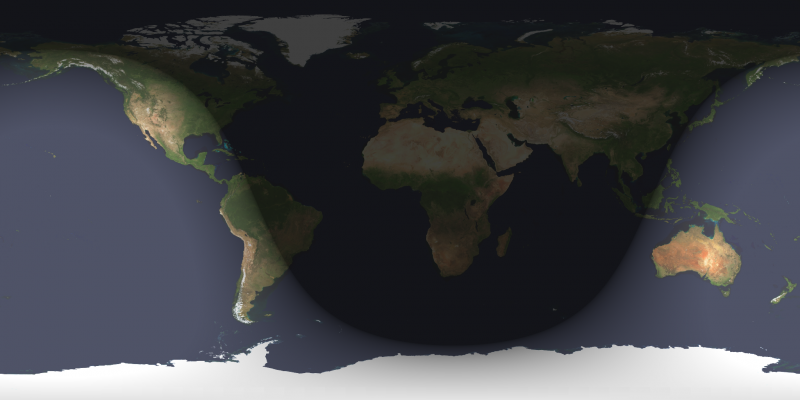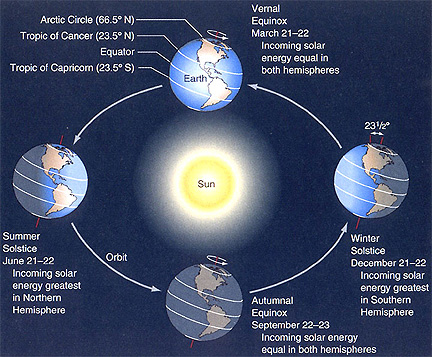
Image above: “First light of winter,” wrote Karl Diefenderfer in Yardley, Pennsylvania.
You might think of the solstice as a day, but it’s really a moment. The December solstice happens at 22:23 UTC on December 21, 2018. That time – the moment of solstice – marks the sun’s southernmost point in our sky for this year.
Here in North America, the solstice happens on December 21 (5:23 p.m. EST, 4:23 p.m. CST, 3:23 p.m. MST, 2:23 p.m. PST, 1:23 p.m. Alaskan Time and 12:23 p.m. Hawaiian Time). When is the moment of solstice for your location? Translate 16:28 UTC to your time zone, here.
This month’s full moon happens less than one day after the December solstice: December 22, 2018 at 17:49 UTC. Expect to see a full-looking moon lighting up sky for most of the night on December 21, starting at evening dusk. The last time the December solstice and full moon happened less than one day apart was in 2010, and the next time will be 2029. Read more about December’s full moon.
Looking at the world map below, you can see that the 2018 December solstice happens when it’s sunset (December 21) in the Americas, sunrise (December 22) along the Asian Pacific Coast, noontime (December 21) for Hawaii and Alaska yet midnight (December 21-22) for Africa and Europe.
By noontime, we mean midday, or midway between sunrise and sunset. By midnight, we mean the middle of the night, or midway between sunset and sunrise.

Day and night sides of Earth at the instant of the December 2018 solstice (December 21, 2018 at 22:23 UTC). Image via U.S. Naval Observatory.
On the December solstice, we celebrate the unofficial first day of winter in the Northern Hemisphere and first day of summer in the Southern Hemisphere. Unofficial? Yes. Winter and summer start at the solstices by tradition, not official decree.
Yet these solstices bring very real occurrences to our sky, which you can witness for yourself. In both the Northern and Southern Hemispheres, the December solstice brings the southernmost sunrise and the southernmost sunset of the year. If you stand in one spot day after day, week after week – for example, gazing out a particular window toward the sunrise or sunset on the horizon – you will surely notice the sunset’s northward trek along the horizon over the coming months.
From time to time, try fixing a bit of tape to your window, on which you’ve written the date, to help you mark the sun’s passage. Or notice it with respect to landmarks in your surroundings, as Peter Lowenstein did, below:
Solstice sunsets, showing the sun’s position on the local horizon at December (left) and June (right) solstices from Mutare, Zimbabwe via Peter Lowenstein.
In the Northern Hemisphere, the southernmost sunrise and sunset usher in the year’s shortest day and the longest night.
In the Southern Hemisphere, it’s the exact opposite, where the year’s southernmost sunrise and sunset give the Southern Hemisphere its longest day and shortest night.
Not everyplace worldwide has a sunrise and a sunset on the day of the December solstice. North of the Arctic Circle – or north of 66.5 degrees north latitude – there is no sunrise or sunset today, because the sun stays beneath the horizon all day long. South of the Antarctic Circle – at 66.5 degrees south of the equator – you won’t see a sunrise or sunset either, because the sun stays above the horizon all day.
After the sun reaches its southernmost point on the sky’s dome on the December solstice, watch as the sun seems to pause for a number of days before it starts its northward trajectory on the sky’s dome once again.

Earth has seasons because our world is tilted on its axis with respect to our orbit around the sun. Image via NASA.
Bottom line: In 2018, the December solstice comes on December 21 at 4:23 p.m. CST. That’s December 21 at 22:23 UTC. It’s when the sun on our sky’s dome reaches its farthest southward point for the year. Happy solstice, everyone!
Want more? Click here to read more about the December solstice
EarthSky lunar calendars are cool! They make great gifts. Order now. Going fast!
from EarthSky http://bit.ly/2EBkuuS

Image above: “First light of winter,” wrote Karl Diefenderfer in Yardley, Pennsylvania.
You might think of the solstice as a day, but it’s really a moment. The December solstice happens at 22:23 UTC on December 21, 2018. That time – the moment of solstice – marks the sun’s southernmost point in our sky for this year.
Here in North America, the solstice happens on December 21 (5:23 p.m. EST, 4:23 p.m. CST, 3:23 p.m. MST, 2:23 p.m. PST, 1:23 p.m. Alaskan Time and 12:23 p.m. Hawaiian Time). When is the moment of solstice for your location? Translate 16:28 UTC to your time zone, here.
This month’s full moon happens less than one day after the December solstice: December 22, 2018 at 17:49 UTC. Expect to see a full-looking moon lighting up sky for most of the night on December 21, starting at evening dusk. The last time the December solstice and full moon happened less than one day apart was in 2010, and the next time will be 2029. Read more about December’s full moon.
Looking at the world map below, you can see that the 2018 December solstice happens when it’s sunset (December 21) in the Americas, sunrise (December 22) along the Asian Pacific Coast, noontime (December 21) for Hawaii and Alaska yet midnight (December 21-22) for Africa and Europe.
By noontime, we mean midday, or midway between sunrise and sunset. By midnight, we mean the middle of the night, or midway between sunset and sunrise.

Day and night sides of Earth at the instant of the December 2018 solstice (December 21, 2018 at 22:23 UTC). Image via U.S. Naval Observatory.
On the December solstice, we celebrate the unofficial first day of winter in the Northern Hemisphere and first day of summer in the Southern Hemisphere. Unofficial? Yes. Winter and summer start at the solstices by tradition, not official decree.
Yet these solstices bring very real occurrences to our sky, which you can witness for yourself. In both the Northern and Southern Hemispheres, the December solstice brings the southernmost sunrise and the southernmost sunset of the year. If you stand in one spot day after day, week after week – for example, gazing out a particular window toward the sunrise or sunset on the horizon – you will surely notice the sunset’s northward trek along the horizon over the coming months.
From time to time, try fixing a bit of tape to your window, on which you’ve written the date, to help you mark the sun’s passage. Or notice it with respect to landmarks in your surroundings, as Peter Lowenstein did, below:
Solstice sunsets, showing the sun’s position on the local horizon at December (left) and June (right) solstices from Mutare, Zimbabwe via Peter Lowenstein.
In the Northern Hemisphere, the southernmost sunrise and sunset usher in the year’s shortest day and the longest night.
In the Southern Hemisphere, it’s the exact opposite, where the year’s southernmost sunrise and sunset give the Southern Hemisphere its longest day and shortest night.
Not everyplace worldwide has a sunrise and a sunset on the day of the December solstice. North of the Arctic Circle – or north of 66.5 degrees north latitude – there is no sunrise or sunset today, because the sun stays beneath the horizon all day long. South of the Antarctic Circle – at 66.5 degrees south of the equator – you won’t see a sunrise or sunset either, because the sun stays above the horizon all day.
After the sun reaches its southernmost point on the sky’s dome on the December solstice, watch as the sun seems to pause for a number of days before it starts its northward trajectory on the sky’s dome once again.

Earth has seasons because our world is tilted on its axis with respect to our orbit around the sun. Image via NASA.
Bottom line: In 2018, the December solstice comes on December 21 at 4:23 p.m. CST. That’s December 21 at 22:23 UTC. It’s when the sun on our sky’s dome reaches its farthest southward point for the year. Happy solstice, everyone!
Want more? Click here to read more about the December solstice
EarthSky lunar calendars are cool! They make great gifts. Order now. Going fast!
from EarthSky http://bit.ly/2EBkuuS

Aucun commentaire:
Enregistrer un commentaire